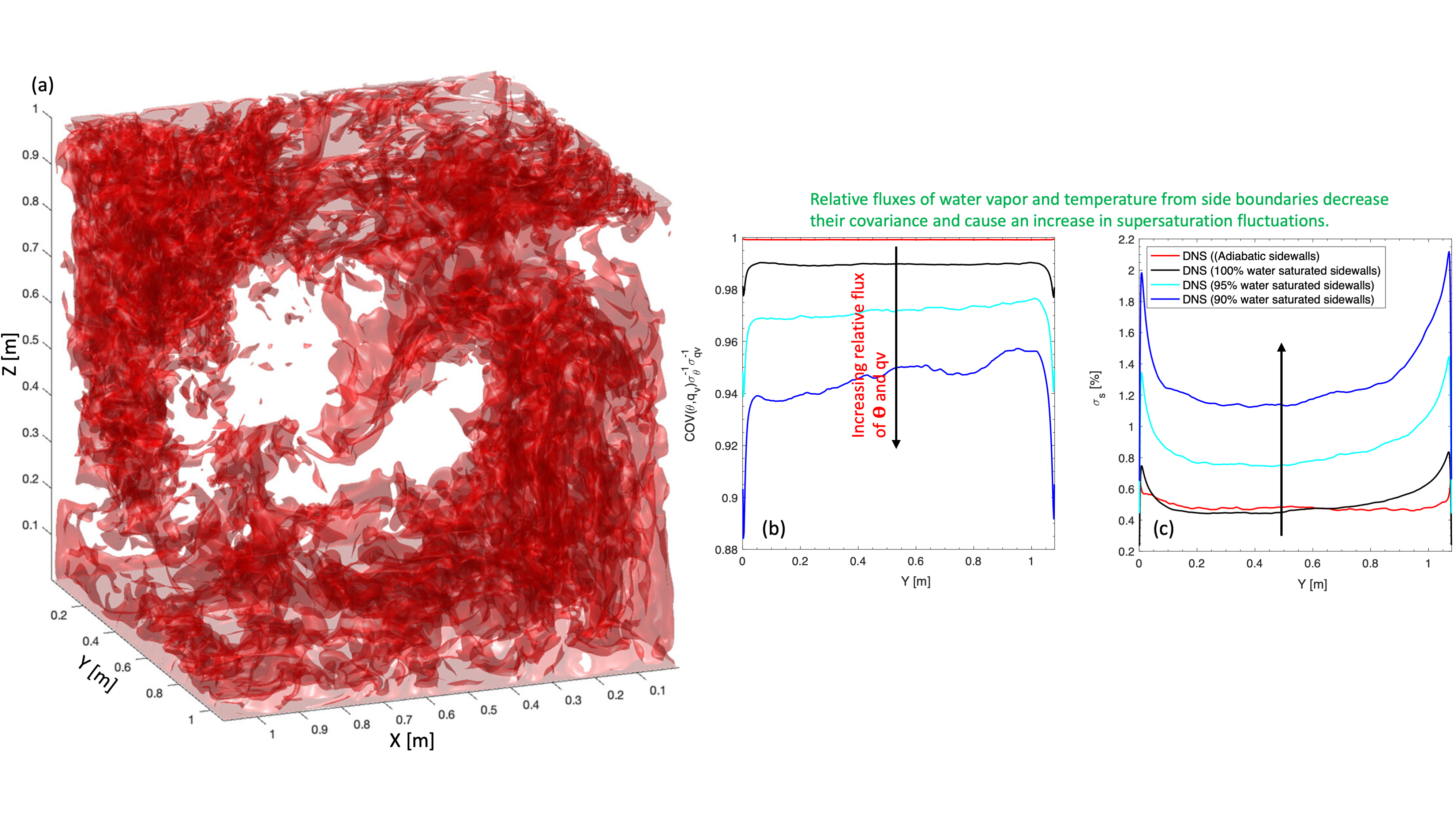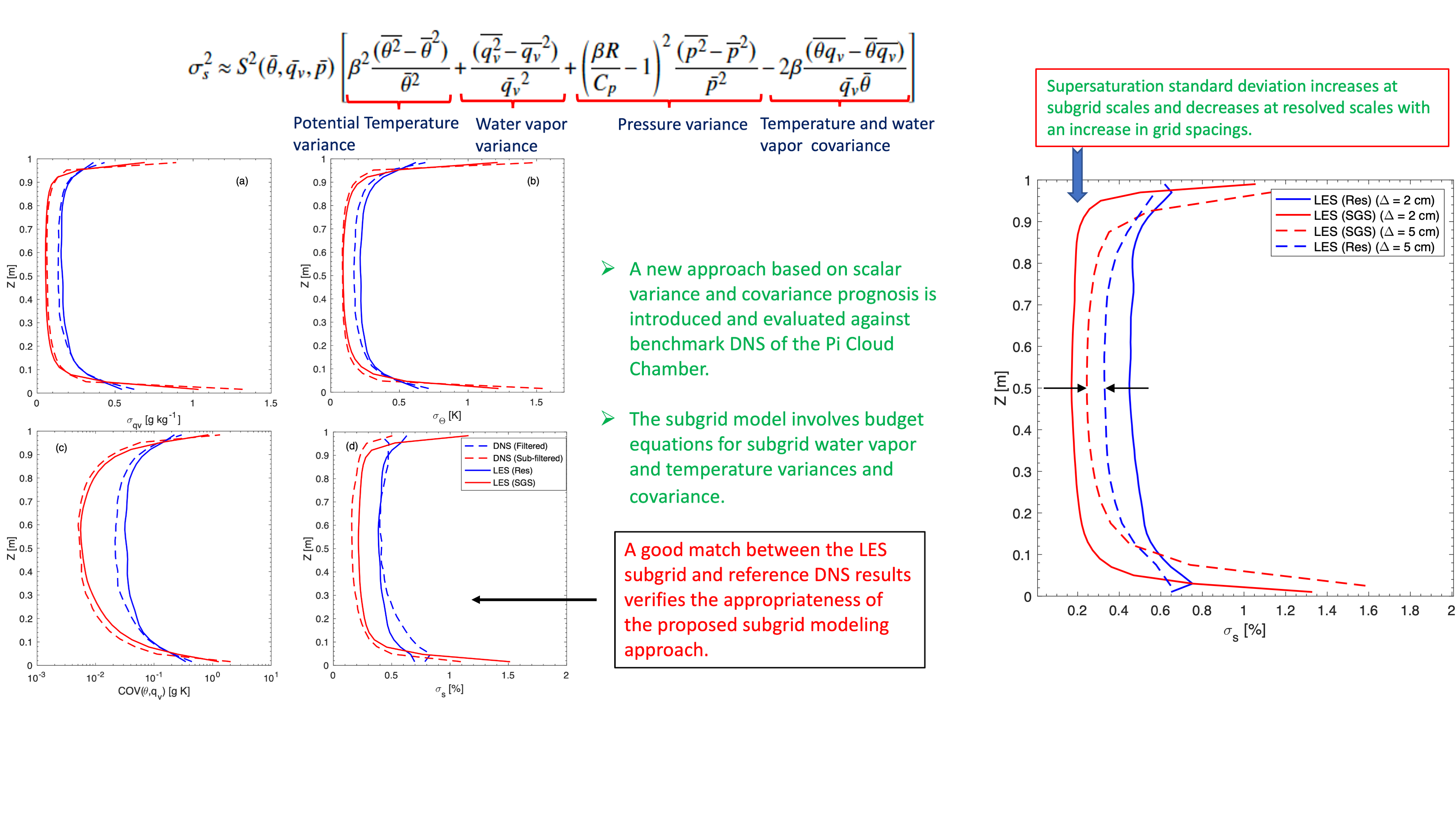Supersaturation variability from scalar mixing: Evaluation of a new subgrid-scale model using DNS
Submitter
Chandrakar, Kamal Kant — NSF National Center for Atmospheric Research
Morrison, Hugh Clifton
— University Corporation for Atmospheric Research
Area of Research
Cloud Processes
Journal Reference
Chandrakar K, H Morrison, W Grabowski, G Bryan, and R Shaw. 2022. "Supersaturation Variability from Scalar Mixing: Evaluation of a New Subgrid-Scale Model Using Direct Numerical Simulations of Turbulent Rayleigh–Bénard Convection." Journal of the Atmospheric Sciences, 79(4), 10.1175/JAS-D-21-0250.1.
Science

Figure 1. (a) Iso-surfaces of supersaturation during the turbulent mixing process from a DNS run of Rayleigh-Bénard convection (the Pi Cloud Chamber). (b-c) Horizontal profiles of water vapor-temperature covariance and supersaturation variance for DNS with different sidewall saturation conditions. From journal.

Figure 2. Vertical profiles of the standard deviation of water vapor mixing ratio fluctuations, the standard deviation of potential temperature fluctuations, the covariance between potential temperature and water vapor mixing ratio fluctuations, and the standard deviation of supersaturation fluctuations from LES resolved and subgrid scales. They are compared with filtered and sub-filtered (at the same length scale as the LES grid box) reference DNS data. From journal.
Supersaturation is a key driver for cloud droplet activation and growth, and its nonlinear dependence on water vapor and temperature increases supersaturation fluctuations in the presence of relative water vapor and temperature fluxes in turbulent convection, as typically occurs during entrainment and mixing of environmental and cloudy air. A new advanced subgrid model is proposed to represent its subgrid turbulent variability and cloud-turbulence interactions in atmospheric models.
Impact
A new subgrid supersaturation scheme based on water vapor and temperature variances and their covariance for large-eddy simulations (LES) and convection-permitting models compares well with benchmark direct-numerical simulations (DNS) of the Pi Cloud Chamber and scales appropriately with grid resolution. This scheme can improve the representation of cloud-turbulence interactions in the benchmark atmospheric models. DNS also shows that relative changes in water vapor and temperature fluxes substantially decrease the covariance and increase supersaturation fluctuations in turbulent convection.
Summary
Supersaturation fluctuations in the atmosphere are critical for cloud processes. Their nonlinear dependence on water vapor and temperature lead to different behavior than single scalars in turbulent convection. For modeling such multiscalar processes at subgrid scales in LES or convection-permitting models, a new subgrid scheme is implemented in the CM1 model that solves equations for subgrid water vapor and temperature fluctuations and their covariance. The subgrid model is evaluated using benchmark DNS of turbulent Rayleigh–Bénard convection with water vapor as in the Michigan Tech Pi Cloud Chamber. DNS results compare favorably with measurements from the chamber. Results from LES using the new subgrid model compare well with DNS, including profiles of water vapor and temperature variances, their covariance, and supersaturation variance. Subgrid supersaturation fluctuations scale appropriately with changes to the LES grid spacing. Sensitivities of covariance and supersaturation statistics to changes in water vapor flux relative to thermal flux (e.g., entrainment-mixing in atmospheric clouds) are also investigated by modifying the sidewall conditions. Relative changes in water vapor flux substantially decrease the covariance and increase supersaturation fluctuations even away from boundaries.
Keep up with the Atmospheric Observer
Updates on ARM news, events, and opportunities delivered to your inbox
ARM User Profile
ARM welcomes users from all institutions and nations. A free ARM user account is needed to access ARM data.


















